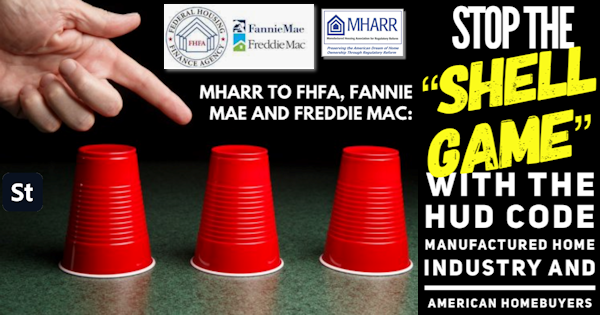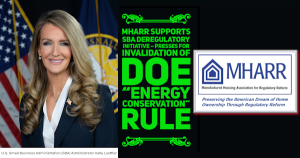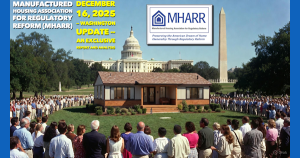MHARR to FHFA, Fannie Mae and Freddie Mac: Stop the “Shell Game” with the HUD Code Manufactured Home Industry and American Homebuyers

STATEMENT OF MARK WEISS
MARCH 25, 2021 ENTERPRISE HOUSING GOALS LISTENING SESSION
My name is Mark Weiss, and I am President and CEO of the Manufactured Housing Association for Regulatory Reform (MHARR).
MHARR, based in Washington, D.C., represents independent producers of manufactured housing regulated under federal law by the U.S. Department of Housing and Urban Development (HUD).
MHARR’s member companies are located in and produce homes that are sold in all regions of the United States.
Manufactured homes are specifically recognized – and protected – under federal law as a leading source of non-subsidized, inherently affordable homeownership, and are regulated under a system that is expressly designed to maintain their affordability in a manner that is consistent with both quality and consumer safety.
Because manufactured homes are federally-regulated under a system that is designed to maintain their inherent affordability, the average structural price of a manufactured home in 2019, according to the U.S. Census Bureau, was $81,900, while the average structural price of a site-built home that same year, was $299,415. Put differently, the cost of an average site-built home is 265% greater than the cost of a manufactured home.
Because of this price advantage and the crucial role that inherently affordable manufactured housing could — and should — play in alleviating the nation’s affordable housing crisis, Congress specifically included HUD-regulated manufactured housing as part of its “Duty to Serve Underserved Markets” (DTS) mandate, enacted in 2008.
Thirteen years after the enactment of the DTS mandate, however, the vast bulk of the mainstream manufactured home consumer lending market represented by personal property (or “chattel”) loans remains completely unserved under DTS.
Nor is there any pending plan or target for the Enterprises to serve the manufactured housing chattel market under DTS through at least the end of 2021, based on DTS implementation plans already reviewed and approved by the Federal Housing Finance Agency (FHFA).
Consequently, more than a decade after the enactment of DTS to, among other things, increase mainstream manufactured housing consumer loan market support by Fannie Mae and Freddie Mac, the nearly 80% of all manufactured home loans represented by chattel obligations, have been completely excluded.
Meanwhile, Fannie and Freddie – with the overt blessing of FHFA – have prioritized DTS support for a much smaller and much more costly set of “boutique” manufactured homes, titled as real property and denominated as “MH Advantage,” “ChoiceHome,” or “Cross-Mod” homes. These homes, which are produced almost entirely by the industry’s largest corporate conglomerates, are totally outside of the industry’s mainstream and represent only a miniscule number of originations.
Consequently, the vast bulk of the manufactured housing consumer lending market continues to be entirely ignored by Fannie and Freddie under DTS. Indeed, purchases of manufactured housing real estate loans by both Enterprises constituted just 5% of the new HUD Code manufactured housing market in 2017, 5.78% of the new HUD Code market in 2018, and just 6.46% of the new HUD Code market in 2019. By contrast, that left 93% of the new HUD Code market completely unserved under DTS in 2019, and more than 94% of the new HUD Code market completely unserved under DTS in both 2018 and 2017.
This represents a “double-whammy” for manufactured housing and lower and moderate-income mainstream manufactured housing consumers, because FHFA, contemporaneously with its proposal of a DTS “implementation” rule in 2010, removed manufactured homes – which had previously been part of the Enterprise Housing Goals (EHG) – from that program.
Prior to 2010, as FHFA has acknowledged, the EHG “regulation defined the term ‘mortgage’ to include a loan secured by ‘a manufactured home that is personal property under the laws of the state in which the manufactured home is located.”
The exclusion of manufactured home personal property loans from EHG, together with their simultaneous exclusion from DTS to date, has left mainstream, affordable manufactured homes and mainstream, affordable manufactured home consumers out in the cold, with no support whatsoever from the Enterprises under any program. This represents both a broken promise to manufactured housing consumers and open defiance of Congress, which made clear its intent to ensure a market-significant level of support for affordable, mainstream manufactured housing.
As a result of FHFA’s exclusion of mainstream manufactured housing personal property loans from both EHG and DTS, through an illegitimate regulatory “shell game,” the vast bulk of the mainstream manufactured housing consumer financing market is not currently being served by the Enterprises under either DTS or the Enterprise Housing Goals.
Following the 2010 “mortgage” definition regulatory modification that deleted Enterprise Housing Goals credit for purchases of personal property manufactured housing consumer loans, FHFA publicly stated its willingness to restore such credit in a “future rulemaking.”
That “future rulemaking” should – and must — be now. Now is the time for Fannie and Freddie to stop making excuses for failing to implement chattel manufactured home loan support under DTS. And now is the time for FHFA to finally require market-significant Enterprise support for such loans under both DTS and the Enterprise Housing Goals.
The facts have shown, over the past decade-plus, that FHFA’s linkage between DTS and EHG with respect to manufactured home consumer lending support, has been a failure that has left manufactured homebuyers with virtually no support whatsoever, under both DTS and EHG, contrary to the express desire of Congress to promote, enhance and advance DTS support for mainstream manufactured housing loans and mainstream manufactured housing consumers.
That failed policy should be ended immediately and FHFA should take responsibility in ensuring that Congress’ objective to ensure strong secondary market support for mainstream manufactured housing consumer loans is achieved.
Accordingly, FHFA should both reincorporate mainstream manufactured home consumer lending support within EHG and require market significant manufactured housing support under DTS as well.
STATEMENT OF MARK WEISS
MARCH 25, 2021 ENTERPRISE HOUSING GOALS LISTENING SESSION
My name is Mark Weiss, and I am President and CEO of the Manufactured Housing Association for Regulatory Reform (MHARR).
MHARR, based in Washington, D.C., represents independent producers of manufactured housing regulated under federal law by the U.S. Department of Housing and Urban Development (HUD).
MHARR’s member companies are located in and produce homes that are sold in all regions of the United States.
Manufactured homes are specifically recognized – and protected – under federal law as a leading source of non-subsidized, inherently affordable homeownership, and are regulated under a system that is expressly designed to maintain their affordability in a manner that is consistent with both quality and consumer safety.
Because manufactured homes are federally-regulated under a system that is designed to maintain their inherent affordability, the average structural price of a manufactured home in 2019, according to the U.S. Census Bureau, was $81,900, while the average structural price of a site-built home that same year, was $299,415. Put differently, the cost of an average site-built home is 265% greater than the cost of a manufactured home.
Because of this price advantage and the crucial role that inherently affordable manufactured housing could — and should — play in alleviating the nation’s affordable housing crisis, Congress specifically included HUD-regulated manufactured housing as part of its “Duty to Serve Underserved Markets” (DTS) mandate, enacted in 2008.
Thirteen years after the enactment of the DTS mandate, however, the vast bulk of the mainstream manufactured home consumer lending market represented by personal property (or “chattel”) loans remains completely unserved under DTS.
Nor is there any pending plan or target for the Enterprises to serve the manufactured housing chattel market under DTS through at least the end of 2021, based on DTS implementation plans already reviewed and approved by the Federal Housing Finance Agency (FHFA).
Consequently, more than a decade after the enactment of DTS to, among other things, increase mainstream manufactured housing consumer loan market support by Fannie Mae and Freddie Mac, the nearly 80% of all manufactured home loans represented by chattel obligations, have been completely excluded.
Meanwhile, Fannie and Freddie – with the overt blessing of FHFA – have prioritized DTS support for a much smaller and much more costly set of “boutique” manufactured homes, titled as real property and denominated as “MH Advantage,” “ChoiceHome,” or “Cross-Mod” homes. These homes, which are produced almost entirely by the industry’s largest corporate conglomerates, are totally outside of the industry’s mainstream and represent only a miniscule number of originations.
Consequently, the vast bulk of the manufactured housing consumer lending market continues to be entirely ignored by Fannie and Freddie under DTS. Indeed, purchases of manufactured housing real estate loans by both Enterprises constituted just 5% of the new HUD Code manufactured housing market in 2017, 5.78% of the new HUD Code market in 2018, and just 6.46% of the new HUD Code market in 2019. By contrast, that left 93% of the new HUD Code market completely unserved under DTS in 2019, and more than 94% of the new HUD Code market completely unserved under DTS in both 2018 and 2017.
This represents a “double-whammy” for manufactured housing and lower and moderate-income mainstream manufactured housing consumers, because FHFA, contemporaneously with its proposal of a DTS “implementation” rule in 2010, removed manufactured homes – which had previously been part of the Enterprise Housing Goals (EHG) – from that program.
Prior to 2010, as FHFA has acknowledged, the EHG “regulation defined the term ‘mortgage’ to include a loan secured by ‘a manufactured home that is personal property under the laws of the state in which the manufactured home is located.”
The exclusion of manufactured home personal property loans from EHG, together with their simultaneous exclusion from DTS to date, has left mainstream, affordable manufactured homes and mainstream, affordable manufactured home consumers out in the cold, with no support whatsoever from the Enterprises under any program. This represents both a broken promise to manufactured housing consumers and open defiance of Congress, which made clear its intent to ensure a market-significant level of support for affordable, mainstream manufactured housing.
As a result of FHFA’s exclusion of mainstream manufactured housing personal property loans from both EHG and DTS, through an illegitimate regulatory “shell game,” the vast bulk of the mainstream manufactured housing consumer financing market is not currently being served by the Enterprises under either DTS or the Enterprise Housing Goals.
Following the 2010 “mortgage” definition regulatory modification that deleted Enterprise Housing Goals credit for purchases of personal property manufactured housing consumer loans, FHFA publicly stated its willingness to restore such credit in a “future rulemaking.”
That “future rulemaking” should – and must — be now. Now is the time for Fannie and Freddie to stop making excuses for failing to implement chattel manufactured home loan support under DTS. And now is the time for FHFA to finally require market-significant Enterprise support for such loans under both DTS and the Enterprise Housing Goals.
The facts have shown, over the past decade-plus, that FHFA’s linkage between DTS and EHG with respect to manufactured home consumer lending support, has been a failure that has left manufactured homebuyers with virtually no support whatsoever, under both DTS and EHG, contrary to the express desire of Congress to promote, enhance and advance DTS support for mainstream manufactured housing loans and mainstream manufactured housing consumers.
That failed policy should be ended immediately and FHFA should take responsibility in ensuring that Congress’ objective to ensure strong secondary market support for mainstream manufactured housing consumer loans is achieved.
Accordingly, FHFA should both reincorporate mainstream manufactured home consumer lending support within EHG and require market significant manufactured housing support under DTS as well.












